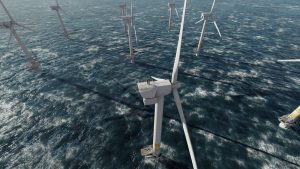10Mins
The need to reassess your offshore GT filtration system
10Mins
However, in the offshore (and coastal) environment wind turbines and substations face a continuous exposure to high concentrations of salt and water, this is in addition to any onshore contamination that is blown offshore. If inadequate filtration is used in this environment it can be very costly and lead to corrosion and damage to electrical components. If salt and moisture reach critical components, it has the potential to lead to downtime, costly repairs and ultimately equipment failure.
Understanding the offshore air quality
Wind turbines in offshore and coastal locations are often exposed to very harsh conditions. The filtration challenge in these applications arrives when the prevailing wind picks up sea spray laden with salt and moisture. Salt corrosion and water ingress can pose a major threat to wind turbine operational efficiency.
Air particles in the offshore environment are typically too small to see with the naked eye and are measured using microns. For context, a typical human hair has a width of between 40-100 microns but in the world of air filtration a particle of between 5-10 microns would be considered large and particles between 0.1 and 1 micron are much more prevalent. In fact, in the offshore environment, approximately 98% of the particles are less than 1 micron and the volume of particles is also misunderstood. When you consider a volume of indoor air of approx. 1 m³ has in the region of 19 million air particles you start to understand the scale of the filtration challenge offshore.

Key findings from offshore oil and gas
AAF International has gained comprehensive experience in the offshore environment through its gas turbine solutions business, which has been installing new filtration systems and upgrading inadequate filtration systems for several decades. AAF also has studied air quality offshore at the platform level which highlighted some misconceptions in the research published by the National Gas Turbine Establishment (NGTE) on offshore air quality guidance. For more detail on this topic please see the related blog article and webinar below.
Offshore wind air filtration systems
Offshore wind turbines are now taller than ever, already the height of the Statue of Liberty, and they are expected to increase in height even further. Therefore, the knowledge gained at platform height offshore in the offshore oil and gas sector can be used to determine the optimum filtration solution for a wind turbine nacelle or tower. The same knowledge can also be applied to substations, which perform such a critical role in the overall operation of a wind farm.
These filtration systems will play a significant role in operational performance. The nacelle of each wind turbine needs to be protected from air contamination to protect critical components such as the generator, gearbox, brake, and control electronics. An air ventilation module stops equipment from overheating and ensures the area is well-ventilated. In wind turbine towers offshore air is used for air conditioning and ventilation, allowing air to circulate to key components and avoiding overheating. Finally, offshore wind farm substations connect the energy generated by the wind turbines to the power grid. They play a critical role in the power generation progress and contain equipment that must be protected from the harsh offshore environment to ensure continuous operation and reduced maintenance costs.
A dedicated offshore solution
The filtration landscape can be confusing, at AAF, we design specialist filters for dedicated environments. We have engineered products specific to the offshore environment, designed to remove high levels of salt and water from the intake air. We are also aware this is a remote location with limited access so understand the importance of a robust and durable design, that is easy to install and handle and has a long filter life.
Once installed offshore the filter will capture harmful air particles on depth-loading filter media and the hydrophobic properties separate the water and harmlessly drain it away. This prevents corrosion and ensures efficient operation. As the filter becomes loaded with particles it is also necessary to have a suitable filter design to ensure differential pressure remains low to reduce energy consumption.
AAF has been supplying air filtration systems to the energy sector for over 50 years and has thousands of installations around the world. Our years of experience make us the ideal partner for offshore wind filtration. We can supply a range of filtration efficiencies from F7 up to EPA E12, which removes 99.5% of particles at the most penetrating particle size (MPPS). MPPS is typically between 0.1 and 0.2 microns.
Our aim is simple, to protect your capital equipment, reduce maintenance costs and increase the life of critical components. Speak to AAF to understand how we can improve your reliability and lower maintenance costs.